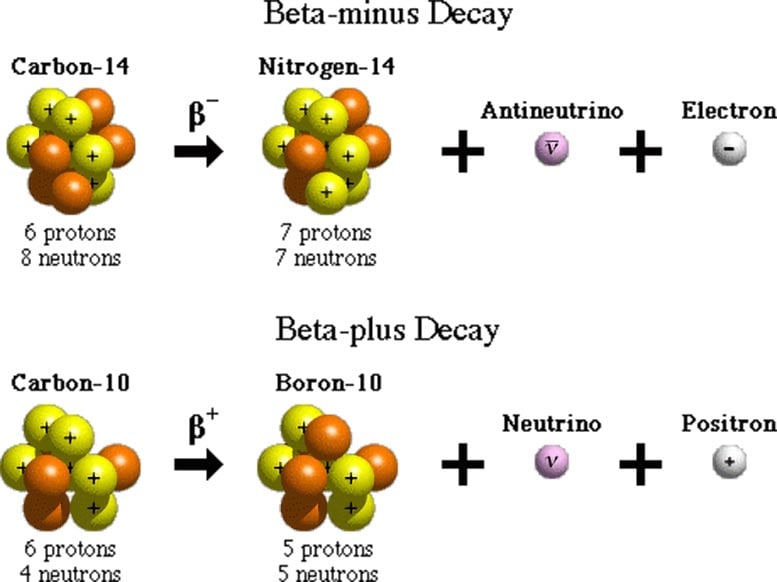Science Made Simple: What Is Beta Decay?

By

Beta decay, the primary mechanism for radioactive decay in unstable isotopes, involves the transformation of neutrons into protons (beta-minus decay) or protons into neutrons (beta-plus decay), with the emission of electrons, positrons, neutrinos, or antineutrinos. Additionally, rare and theoretical forms like two-neutrino double-beta decay and the hypothetical neutrino-less double-beta decay could significantly impact our understanding of particle physics, particularly concerning the mass and nature of neutrinos. Credit: SciTechDaily.com
What Is Beta Decay?
Beta decay is the most common form of radioactive decay. It happens in one of two ways. In one type of beta decay, an unstable atomic nucleus emits an electron and an antineutrino while converting a neutron to a proton. In the second type, the unstable nucleus emits a positron (a positively charged electron, also called an antielectron) and a neutrino while converting a proton to a neutron. Positrons and electrons are beta particles. Scientists have observed beta decay in 97% of all known unstable isotopes. It occurs in nuclei with too many neutrons or too many protons.
Scientists have observed two main types of beta decay. The first is beta-minus decay. In this form, a nucleus emits an electron and an antineutrino (the antimatter form of a neutrino). This process changes a neutron in the nucleus into a proton. The second type of beta decay is beta-plus decay. In this form, the nucleus emits a neutrino and a positron (the antimatter form of an electron). This process changes a proton in the nucleus into a neutron.

Beta decay occurs primarily through the transformation of neutrons to protons or vice versa, releasing particles like electrons and neutrinos. Credit: Thomas Jefferson National Accelerator Facility (JLab)
There are also rare types of beta decay. One example is two-neutrino double-beta decay. This is a transition inside a nucleus where two neutrons simultaneously undergo beta decay. In other words, two neutrons decay to two protons by emitting two neutrinos and two electrons.
Another theoretically possible type of beta decay is neutrino-less double-beta decay. In this form of beta decay, a nucleus would decay to two protons by emitting two electrons. This form has never been observed. If neutrino-less double-beta decay exists, it would mean that the neutrino has mass and is what scientists call a Majorana particle. These are particles that are identical to their antiparticles.
If scientists observe neutrino-less double-beta decay, it would help to explain missing pieces of the Standard Model of Particle Physics. The Standard Model cannot explain how neutrinos have mass. Neutrino-less double-beta decay could be the mechanism that generates the neutrino’s mass.
Beta Decay Facts
DOE Contributions to Radioactive Decay Research
DOE has a long history of supporting research into nuclear physics, including radioactive decay and the subatomic particles this decay involves. Researchers supported by the DOE Office of Science, often in collaboration with scientists from around the world, have contributed to Nobel Prize-winning discoveries and measurements that refined the Standard Model. These efforts continue today, with experiments that make precision tests of the Standard Model and beyond. To address neutrino-less double-beta decay specifically, DOE is participating in the Large Enriched Germanium Experiment for Neutrino-less Double beta decay (LEGEND) Collaboration at Oak Ridge National Laboratory, the CUORE experiment in Italy, and the MAJORANA DEMONSTRATOR experiment in South Dakota.



